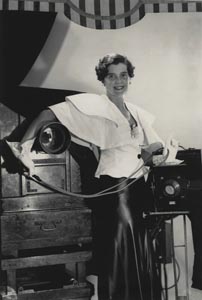Yevonde Middleton facts for kids
Quick facts for kids
Yevonde Middleton
|
|
|---|---|

Self portrait
|
|
| Born |
Yevonde Philone Cumbers
5 January 1893 Streatham, London, United Kingdom
|
| Died | 22 December 1975 (aged 82) London, United Kingdom
|
| Nationality | British |
| Known for | Photography |
| Spouse(s) |
Edgar Middleton
(m. 1920; died 1939) |
Yevonde Philone Middleton (born Yevonde Cumbers; 5 January 1893 – 22 December 1975) was a British photographer. She was one of the first to use colour in portrait photography. She was known professionally as Madame Yevonde and worked for over 60 years.
Contents
Early Life and Photography Training
Yevonde Philone Cumbers was born on 5 January 1893 in Streatham, London. She was the older of two sisters. Her family moved to Bromley in 1899. Yevonde went to different schools in England, France, and Belgium. She was always very independent.
From a young age, Yevonde was inspired by Mary Wollstonecraft, a famous supporter of women's rights. In 1910, Yevonde joined the Suffragette movement. This group worked to get women the right to vote.
After school, Yevonde returned home. She was active in the suffragette movement for a while. She saw an advertisement in The Suffragette newspaper looking for a photography apprentice.
Instead of that job, Yevonde found an apprenticeship with Lallie Charles, a portrait photographer. Yevonde learned many technical skills there. With £250 from her father, she opened her own studio in London at age 21. She quickly became known for her work. She invited famous people to pose for free. Soon, her photos appeared in popular magazines like the Tatler and The Sketch.
Yevonde's style was different from her teacher's. She moved away from stiff, formal poses. Her photos became more creative. She often showed her subjects looking away from the camera. She also used interesting objects in her pictures.
By 1921, Madame Yevonde was a well-known photographer. She moved to a bigger studio. She started taking photos for advertisements. She also photographed many famous people of her time. These included A. A. Milne, who wrote Winnie-the-Pooh, and writer Barbara Cartland. She also photographed Noël Coward, a famous playwright.
Pioneering Colour Photography
In the early 1930s, Yevonde started trying out colour photography. She used a new process called Vivex. At first, many photographers and people didn't like colour photos. They were used to black-and-white pictures. But Yevonde loved colour. She spent many hours in her studio learning how to get the best results.
Her hard work paid off. In 1932, she had an exhibition (a show) of her portraits. Half were black-and-white, and half were in colour. People loved the colour photos!
In 1933, Madame Yevonde moved her studio again. She started using colour for her advertising work and portraits. She also took on other special projects. In 1936, a magazine asked her to photograph the new ship, the Queen Mary. This was different from her usual work, but it was a big success. Her photos were shown in London and New York City. She even photographed artist Doris Zinkeisen, who painted murals for the ship.
Another big achievement was being asked to take portraits of important people for the coronation of King George VI and Queen Elizabeth. She joined the Royal Photographic Society in 1933. She became a Fellow in 1940, which is a high honour. The RPS Collection still has examples of her work.
Creative Goddesses Series
Yevonde's most famous work was inspired by a fancy dress party in 1935. Guests dressed as Roman and Greek gods and goddesses. Yevonde then took studio portraits of many people from the party. They wore costumes and were surrounded by objects that fit the theme.
This series of photos showed how creative Yevonde was. She used colour, costumes, and props to make her subjects look magical. She later created other series based on the signs of the zodiac and the months of the year. Yevonde was also influenced by surrealist artists like Man Ray. She used surprising combinations of objects, which showed her sense of humour.
This very creative period for Yevonde lasted only a few years. In 1939, the company that made the Vivex colour process closed down. This meant she could no longer use it. It was a difficult year for Yevonde. Her husband, Edgar Middleton, had also passed away earlier that year.
Yevonde went back to working in black and white. She continued to take many important portraits. She kept working until she passed away in 1975, just before her 83rd birthday. She is best remembered for her amazing work in the 1930s. Her work helped make colour photography popular and respected.
Exhibitions
- Be Original or Die Photographs by Madame Yevonde in 1953 showed 64 colour photographs. These included her Goddesses series from 1935. In this series, women from society posed as mythical figures.
- Goddesses and Others: Photographs by Madame Yevonde was shown in 2005 at the National Portrait Gallery, London. It featured 15 of her colour photographs from the 1930s.
- Madame Yevonde: Colour, Fantasy & Myth was a big show of her work at the National Portrait Gallery, London in 1990.
- A new exhibition, "Yevonde: Life and Colour", opened at the National Portrait Gallery in London on 22 June 2023.
Images for kids


